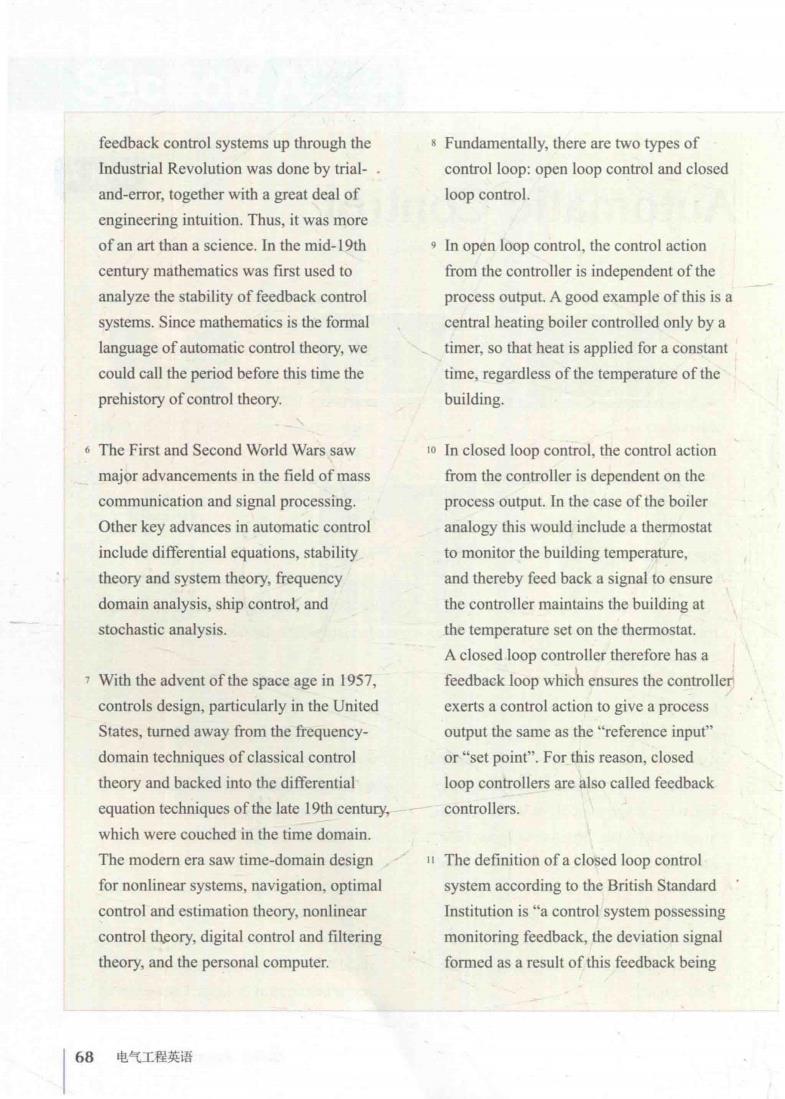正在加载图片...

feedback control systems up through the s Fundamentally,there are two types of Industrial Revolution was done by trial- control loop:open loop control and closed and-error,together with a great deal of loop control. engineering intuition.Thus,it was mor of an art than a science.In the mid-19th In open loop control,the control action century mathematics was first used to from the controller is independent of the analyze the stability of feedback control process output.A good example of this is a systems.Since mathematics is the formal central heating boiler controlled only by a language of automatic control theory,we timer,so that heat is applied for a constant could call the period before this time the time,regardless of the temperature of the prehistory of control theory. building. The First and Second World Wars saw 10 In closed loop control,the control action major advancements in the field of mass from the controller is dependent on the communication and signal processing. process output.In the case of the boiler Other key advances in automatic control analogy this would include a thermostat include differential equations,stability to monitor the building temperature, theory and system theory,frequency and thereby feed back a signal to ensure domain analysis,ship control,and the controller maintains the building at stochastic analysis. the temperature set on the thermostat. A closed loop controller therefore has a With the advent of the space age in 1957 feedback loop which ensures the controller controls design,particularly in the United exerts a control action to give a process States,turned away from the frequency- output the same as the"reference input" domain techniques of classical control or“set point'”.For this reason,closed theory and backed into the differential loop controllers are also called feedback equation techniques of the late 19th century. controllers. which were couched in the time domain. The modern era saw time-domain design The definition of a closed loop control for nonlinear systems,navigation,optima system according to the British Standard control and estimation theory,nonlinear Institution is"a control system possessing control theory,digital control and filtering monitoring feedback,the deviation signal theory,and the personal computer. formed as a result of this feedback being 68电气工程英语 feedback control systems up through the Industrial Revolution was done by trial- . and-error, together with a great deal of engineering intuition. Thus, it was more of an art than a science. In the mid-19th century mathematics was first used to analyze the stability offeedback control systems. Since mathematics is the formal language of automatic control theory, we could call the period before this time the prehistory of control theory. 6 The First and Second World Wars saw major advancements in the field of mass communication and signal processing. Other key advances in automatic control include differential equations, stability theory and system theory, frequency domain analysis, ship control, and stochastic analysis. 1 With the advent of the space age in 1957, controls design, particularly in the United States, turned away from the frequencydomain techniques of classical control theory and backed into the differential 68 equation techniques of the late 19th centu which were couched in the time domain. The modem era saw time-domain design for nonlinear systems, navigation, optimal control and estimation theory, nonlinear control ory, digital control and filtering theory, and the personal computer. 电气工程英语 s Fundamentally, there are two types of control loop: open loop contI·ol and closed loop control. 9 In open loop control, the control action from the controller is independent of the process output. A good example of this is a central heating boiler controlled only by a _ timer, so that heat is applied for a constant time, regardless of the temperature of the building. 10 In closed loop control, the control action from the controller is dependent on the process output. In the case of the boiler analogy this would include a thermostat to monitor the building temperature, and thereby feed back a signal to ensure the controller maintains the building at the temperature set on the thermostat. A closed loop controller therefore has a feedback loop which ensures the controller exerts a control action to give a process output the same as the "reference input" or "set point". For this reason, closed loop controllers are also called feedback controllers. 11 The definition of a closed loop control system according to the British Standard Institution is "a control system possessing monitoring feedback, the deviation signal formed as a result of this feedback being